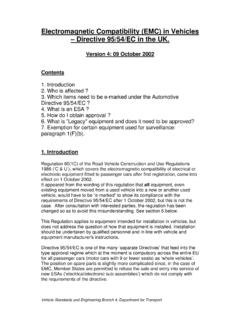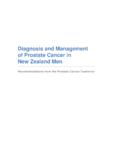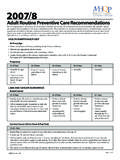Transcription of EMC Test Standards for Automotive Electronic …
1 17 EMC & Compliance Journal September 2003 IntroductionThe electronics content of vehicles has been increasingdramatically, particularly over the last 15 years or so and ispredicted to continue into the next decade, some estimatessuggest the value of electronics in a medium sized vehicle willrepresent 30% of the total vehicle cost by 2010. The increasein vehicle Electronic components and modules has occurrednot only in Electronic control units (ECU) for the vehicle itself,but also more recently in mobile communications, information,security and entertainment systems in the light of this growth it is important that the multiple ECU sin a vehicle are compatible electromagnetically and will notinterfere with off-board systems (especially roadsideequipment).
2 The EMC of vehicles, especially spark ignitionengines, has been a consideration globally for much longerthan most commercial EMC Standards have existed. In Europethe first directive for the suppression of spark-ignition noisewas published in 1972 (72/245/EEC). In North America theSociety of Automotive Engineers (SAE) have had standardsavailable on EMC since the early 1990 s and the InternationalStandards Organisation (ISO) and CISPR have providedautomotive specific EMC Standards since the European Union (EU) there is a specific directive forautomotive EMC (EU directive 95/54/EC which amends 72/245/EEC) that covers the majority of Automotive assembliesas well as the vehicles themselves and is embodied in legislation(several non EU member countries in Europe also adopt thisdirective under regulation ECE ).
3 There is no similarlegislative equivalent in North America (USA and Canada) orthe Rest of the World (RoW), hence Automotive OEM s havedeveloped their own internal Standards that allow them to meetthe requirements of all the geographic markets into which theysell. Consequently the field of Automotive EMC testing mayappear complicated having many different Standards , somespecific to OEM s, some international (CISPR/ISO), somegeographic (SAE in North America) and some legislativerequirements (95/54/EC).Components or Electronic Sub-AssembliesThe term Electronic sub-assembly (ESA) refers to almostany electrical or Electronic device fitted to a vehicle. Thedefinition includes the more obvious sub-systems such asengine management unit (EMU), body control modules (BCM)and heating, ventilation and air-conditioning (HVAC) term ESA also includes what might be otherwiseconsidered as components such as manifold absolute pressure(MAP) sensor, solid-state relays (SSR) and motors.
4 Theinternational Automotive EMC Standards usually refer to bothcomponents and modules as Electronic sub-assemblies and hereno difference will be made between them, although most ofthe discussion will be based on modules rather than are two categories of electrical/ Electronic equipmentfitted to vehicles; those fitted by the vehicle manufacturer(OEM fit) and after-market equipment (user fitted orprofessionally installed). In many cases the same companiesare supplying the OEM and after-market product and thesewill be tested to the same EMC Standards . Equipment intendedas after-market fit only may not be as well regulated withrespect to EMC as OEM fitted and will generally only meetthe minimum requirements for the Emissions StandardsThe two radiated emissions Standards in common use;95/54/EC and CISPR-25, share many common features in theirchamber (Absorber Lined Screened Enclosure; ALSE,figure 1) test set-up and the results of each are almostcomparable.
5 The almost is due to minor and often annoyingdiscrepancies, for example CISPR-25 tests for radiatedemissions specifies the ground plane at from the chamberfloor, 95/54/EC specifies 1m. It is also possible to do the testson an Open Area Test Site (OATS) instead of a chamber, butthe calibration for OATS is significantly more time consumingand consequently more expensive via a test service, hence thepreference for ALSE facilities for these 1: Radiated Emissions measurements from an automotiveESA (satellite navigation display) and harness (photo courtesy ofTrafficmaster/3C Test Ltd)EMC Test Standards for Automotive Electronic ComponentsBy Martin O'Hara, Senior Design Consultant, Telematica Systems LtdTable 1: International Automotive Standards for Component Testing18 EMC & Compliance Journal September 2003 The 95/54/EC standard covers the frequency range 30 MHz to1 GHz with fixed test levels for broadband and narrowbandemissions (figure 2).
6 The levels are contiguous across thefrequency range and are simple pass/fail limits, although aswith most EMC test the absolute limits are complicated bythe standard insetting by 2dB on the quoted reference people test to the quoted limits directly, it is only whenan emission is close to the reference limit that the 2dB insetlevel is used, and if submitting for type approval the final wordis provided by the approval body (the VCA in the case of UKtested products). It is not necessary to test at all the frequenciesin the range 30 MHz to 1 GHz, the directive allows for theselection of 13 test frequencies across this range (within 13defined frequency bands), however, as these test frequenciesare selected from the largest excursions during a pre-scan, it isusual to sweep the whole frequency range rather than selecttest 2: PSA and Ford limit lines extending the test frequencyto 2 GHzCISPR-25 covers a wider frequency range (150kHz to960 MHz) and has broadband and narrowband limits(broadband includes peak and quasi-peak detector limits).
7 Thetest levels are not continuous across this frequency range,instead being applied only to utilised radio frequency bands(figure 3). In CISPR-25 there are five classes of limit that canbe applied, often the customer will specify these, if no specificcustomer requirements ( for the after-market) then themanufacturer often performs the tests and applies whateverlimit the ESA 3: CISPR 25 Broadband peak and 95/54/EC limit linesCISPR-25 includes provision for testing radiated emissions ina TEM cell. The test can be performed up to 175 MHz onlyand includes seven classes of limit lines. The levels are equalacross all the measurement bands in the TEM cell test for eachclass limit. This type of testing is typically performed in-houserather than at a test service, as the wider frequency range andability to test to 95/54/EC at the same time makes the chambera more appealing test solution for test service providers as wellas specifications are based around the CISPR-25 chamberset-up (some also allow the TEM test for the lower frequencyrange).
8 Most fill in the missing measurement bands, however,there is no consistency between OEM on how this is example PSA fill in the intermediate measurement bandsbelow 30 MHz with the lower limit level from the previousband ( if class 4 is applied from 150kHz to 300kHz, class 3limit from this band is applied from 300kHz to 530kHz), above30 MHz the 95/54/EC limits plus 10dB is used in the applies their own (non-CISPR-25) limit level and onlyutilise the test set-up of the standard. Most OEM specificationsextend the upper frequency range, going to 2 GHz to coverGSM frequencies at and , a few extend furtherto and 3 GHz to encompass Bluetooth Immunity StandardsThere are two radiated immunity Standards in common use;95/54/EC for European legislative purposes and ISO 11452for most OEM Standards .
9 There are common tests betweenthe two Standards and both allow a variety of methods to beemployed in the testing. One common test component is theuse of amplitude modulation (AM) at 1kHz to a depth of 80%that is used for both test Standards discussed 4: Automotive ESA (EMU) radiated immunity testing in a150mm stripline (photo courtesy of Motorola)The EU directive 95/54/EC permits testing using both 150mmand 800mm striplines, TEM cell (up to 200 MHz), bulk currentinjection (BCI) and free-field (ALSE). Each test method hasdifferent limits and the directive specifies that tests should beat 25% above the defined limit (table 2). Testing across thecomplete frequency range required by 95/54/EC (20 MHz to1 GHz) is complicated if any method other than free field isused, as most of the other test methods are difficult to calibrateabove 400 MHz.
10 As with the radiated emissions testing, it ispermissible to test at specific test points (14 test points required,frequency bands not explicitly defined).Table 2: Immunity Limit Levels as defined in 95/54/EC19 ISO 11452 comes in 7 parts the first of which is the generaldefinitions, the other 6 are different test methods and limitscomprising of free field (ALSE), TEM, BCI, 150mm stripline,parallel plate antenna and direct RF injection (table 3). Aswith most international Standards there are multiple classes oflimit levels that the manufacturer or customer can specify;typically there are 4 defined classes within each test methodand a user defined class without limits. Although limit levelsdo vary by test method, the classes encompass the range 25V/m to 200V/m for direct field measurement methods, 25mA to100mA for BCI and to for direct 3: ISO 11452 Test Methods and Frequency RangeFigure 5: BCI testing over ground plane(photo courtesy of Trafficmaster/3C Test Ltd)The OEM Standards primarily utilise the methods and limitsof ISO 11452.












